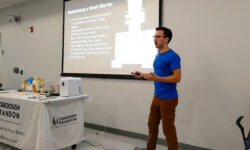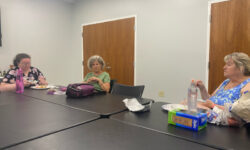[ccfic caption-text format="plaintext"]
By Laura Drinan
Hometown Weekly Reporter
On February 28, Westwood’s turophiles visited the Islington Branch Library for a special program all about cheese. Joining the cheese lovers for the event was the owner of Roslindale’s Boston Cheese Cellar, Adam Shutes.
While many were looking forward to tasting the five cheeses that Adam brought along, they were also excited to learn more about the history of cheese.
“To understand cheese, you kind of have to understand how it’s created,” Adam said. “Cheese making: the idea is really quite simple, and that is to get the water out of milk. That’s kind of how you make cheese. And why? Because it causes spoilage.”
He expanded on the origins of cheese, reiterating that the main reason early cheese makers created it was to prevent milk from spoiling, especially over the long winters when cows did not produce as much milk.
Having completed his undergraduate and graduate degrees in biochemistry in London, Adam came to the States as a scientist and fell into the world of cheese. While it seems like a major shift in careers, Adam’s background in science helped him to better explain how cheese is made.
He discussed the four steps of cheese making: preparing the milk, choosing a coagulant, manipulating the curd, and aging the cheese.
“There are little differences in what we do in each of these steps that will send the potential cheese off in different directions,” Adam said, pointing to the table where the variety of cheeses were laid out.
First, the program-goers, who sat elbow-to-elbow in the one-room library, tasted Brie, a soft-cheese hailing from a French region of the same name. The cheese lovers then compared soft cheese to hard cheese as they tried mozzarella and Parmigiano-Reggiano – two beloved Italian cheeses.
To sample an Alpine cheese, the attendees tasted Swiss cheese. Finally, the visitors tasted Taleggio, a semi-soft cheese with a washed rind.
With so many different kinds of cheeses to try, Adam’s explanations on the process and reasoning of cheese-making gave Westwood’s gourmands a greater understanding of and appreciation for the versatile food.






















